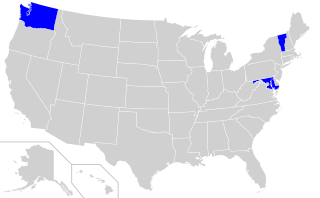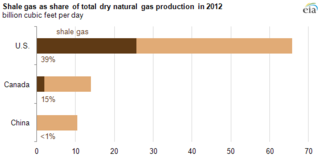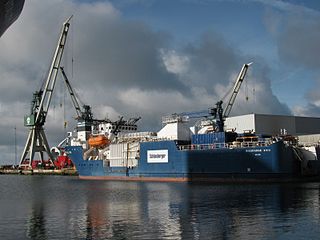History
In the early days of the oil industry, there was no need for stimulation to improve recovery efficiency, because supply vastly outstripped demand and leaving "difficult" oil in the ground was economically expedient. [3] Two world wars, followed by huge economic growth resulted in surging demand for cheap portable energy, [4] while the availability of new conventional oil and gas resources declined. [5] [6] [lower-alpha 4] The industry initially sought to enhance recovery of trapped oil and gas, using techniques like restricted, or low volume hydraulic fracturing to stimulate the reservoir further, [lower-alpha 5] thereby reducing the volume of oil and gas left in the ground to an economic minimum. [7] [lower-alpha 6] By the turn of the millennium, a new kind of energy resource was required, particularly by the USA, who were driven to achieve energy independence. The USA turned to unconventional reservoirs to achieve their goals, [8] which had been known about for decades but had previously been too costly to be economically attractive. Today, unconventional reservoirs include basin-centered gas, shale gas, coalbed methane (CBM), gas hydrates, tar sands, light tight oil and oil shale, mostly from North America. [9] [10]
Essential differences between conventional and unconventional reservoirs
The distinction between conventional and unconventional resources reflects differences in the qualities of the reservoir and/or the physical properties of the oil and gas (i.e. permeability and/or viscosity). [11] [12] [13] These characteristics significantly impact predictability (risk to find, appraise and develop) and in turn the methods of extraction from those reservoirs such as fracking.
Conventional oil & gas accumulations are concentrated by buoyancy driven aquifer pathways into discrete geological traps, which are detectable from the surface. These traps constitute relatively small but high resource density fields. Most conventional oil or gas fields initially flow naturally by buoyancy alone into the well bore, with their limits defined by fluid mechanics measurable from the well bore (e.g. fluid pressure, OWC/GWC etc.). In general, the technical and commercial risk associated with discrete conventional reservoirs can be reduced using relatively inexpensive remote techniques such as reflection seismology and extracted with relatively few appraisal and development wells. [2]
Unconventional reservoirs, in contrast, are regionally dispersed over large areas with no indicative trap geometry that can be used for predictive purposes. The oil and gas in unconventional reservoirs are generally low density resources, frequently trapped in the rock by strong capillary forces incapable of flowing naturally through buoyancy. [14] The limits of an unconventional field are therefore usually defined by relatively expensive well testing for delivery. Extraction from unconventional reservoirs requires changing the physical properties of the reservoir, or the flow characteristics of the fluid, [lower-alpha 7] using techniques such as fracking or steam injection. The technical and commercial risk associated with unconventional reservoirs is generally higher than conventional reservoirs owing to the lack of predictability of the trap extent and of the reservoir quality, which requires extensive well placement and testing to determine the economic reserves/well limit defined by well delivery. [1] [lower-alpha 8]
| Reservoir | Phase | Density [D 1] | Flow [lower-alpha 9] | Main predictors [D 2] | Min extraction [D 3] |
|---|
|
| Conventional [D 4] | Oil & gas | high | buoyancy | Well bore pressure;Reflection seismic | Well bore |
| Basin-centered gas [D 5] | gas | low | capillary | drilling | well bore (fracking) |
| Shale gas [D 6] | gas | low | capillary | drilling | well bore (fracking) |
| Coalbed Methane [D 7] | gas | high | adsorption | drilling | well bore (de-pressurisation) |
| Gas hydrates [D 8] | gas | high | ?buoyancy? | Reflection seismic; drilling | ?mining/well bore? |
| Tar sands [D 9] | oil | high | ?capillary? | drilling/mining | steam flood |
| Light Tight Oil [D 10] | oil | low | capillary | drilling | well bore (fracking) |
| Oil shales [D 11] | oil | high | bonded | mining | retort (sub mature) |
|
Environmental differences
As with all forms of fossil fuel, there are established issues with greenhouse gas emissions through export (distribution) as well as consumption (combustion), which are identical whether the oil or gas are derived from conventional or unconventional reservoirs. [15] Their carbon footprints, however, are radically different: conventional reservoirs use the natural energy in the environment to flow oil and gas to the surface unaided; unconventional reservoirs require putting energy into the ground for extraction, either as heat (e.g. tar sands and oil shales) or as pressure (e.g. shale gas and CBM). The artificial transfer of heat and pressure require the use of large volumes of fresh water creating supply and disposal issues. The distribution of the resource over large areas creates land use issues, with implications for local communities on infrastructure, freight traffic and local economies. Impact on the environment is an unavoidable consequence of all human activity but the difference between the impact of conventional reservoirs compared with unconventional is significant, measurable and predictable. [16] [17]

Natural gas is a naturally occurring mixture of gaseous hydrocarbons consisting primarily of methane in addition to various smaller amounts of other higher alkanes. Low levels of trace gases like carbon dioxide, nitrogen, hydrogen sulfide, and helium are also usually present. Methane is colorless and odorless, and the second largest greenhouse gas contributor to global climate change after carbon dioxide. So odorizers such as mercaptan are commonly added to natural gas supplies for safety so that leaks can be readily detected.

An oil well is a drillhole boring in Earth that is designed to bring petroleum oil hydrocarbons to the surface. Usually some natural gas is released as associated petroleum gas along with the oil. A well that is designed to produce only gas may be termed a gas well. Wells are created by drilling down into an oil or gas reserve that is then mounted with an extraction device such as a pumpjack which allows extraction from the reserve. Creating the wells can be an expensive process, costing at least hundreds of thousands of dollars, and costing much more when in hard to reach areas, e.g., when creating offshore oil platforms. The process of modern drilling for wells first started in the 19th century, but was made more efficient with advances to oil drilling rigs during the 20th century.

Hydrocarbon exploration is the search by petroleum geologists and geophysicists for deposits of hydrocarbons, particularly petroleum and natural gas, in the Earth's crust using petroleum geology.

Coalbed methane, coalbed gas, or coal seam gas (CSG) is a form of natural gas extracted from coal beds. In recent decades it has become an important source of energy in United States, Canada, Australia, and other countries.

A petroleum reservoir or oil and gas reservoir is a subsurface accumulation of hydrocarbons contained in porous or fractured rock formations.
A petroleum geologist is an earth scientist who works in the field of petroleum geology, which involves all aspects of oil discovery and production. Petroleum geologists are usually linked to the actual discovery of oil and the identification of possible oil deposits, gas caps, or leads. It can be a very labor-intensive task involving several different fields of science and elaborate equipment. Petroleum geologists look at the structural and sedimentary aspects of the stratum/strata to identify possible oil traps or tight shale plays.

Petroleum is a fossil fuel that can be drawn from beneath the earth's surface. Reservoirs of petroleum are formed through the mixture of plants, algae, and sediments in shallow seas under high pressure. Petroleum is mostly recovered from oil drilling. Seismic surveys and other methods are used to locate oil reservoirs. Oil rigs and oil platforms are used to drill long holes into the earth to create an oil well and extract petroleum. After extraction, oil is refined to make gasoline and other products such as tires and refrigerators. Extraction of petroleum can be dangerous and have led to oil spills.

In the United States, fracking began in 1949. According to the Department of Energy (DOE), by 2013 at least two million oil and gas wells in the US had been hydraulically fractured, and that of new wells being drilled, up to 95% are hydraulically fractured. The output from these wells makes up 43% of the oil production and 67% of the natural gas production in the United States. Environmental safety and health concerns about hydraulic fracturing emerged in the 1980s, and are still being debated at the state and federal levels.

Natural gas has been used almost as long as crude oil in Canada, but its commercial development was not as rapid. This is because of special properties of this energy commodity: it is a gas, and it frequently contains impurities. The technical challenges involved to first process and then pipe it to market are therefore considerable. Furthermore, the costs of pipeline building make the whole enterprise capital intensive, requiring both money and engineering expertise, and large enough markets to make the business profitable.

Shale gas is an unconventional natural gas that is found trapped within shale formations. Since the 1990s a combination of horizontal drilling and hydraulic fracturing has made large volumes of shale gas more economical to produce, and some analysts expect that shale gas will greatly expand worldwide energy supply.

Well stimulation is a well intervention performed on an oil or gas well to increase production by improving the flow of hydrocarbons from the reservoir into the well bore. It may be done using a well stimulator structure or using off shore ships / drilling vessels, also known as "Well stimulation vessels".

Tight gas is natural gas produced from reservoir rocks with such low permeability that massive hydraulic fracturing is necessary to produce the well at economic rates. The gas is sealed in very impermeable and hard rocks, making their formation "tight". These impermeable reservoirs which produce dry natural gas are also called "Tight Sand".

Tight oil is light crude oil contained in unconventional petroleum-bearing formations of low permeability, often shale or tight sandstone. Economic production from tight oil formations requires the same hydraulic fracturing and often uses the same horizontal well technology used in the production of shale gas. While sometimes called "shale oil", tight oil should not be confused with oil shale or shale oil. Therefore, the International Energy Agency recommends using the term "light tight oil" for oil produced from shales or other very low permeability formations, while the World Energy Resources 2013 report by the World Energy Council uses the terms "tight oil" and "shale-hosted oil".

Fracking is a well stimulation technique involving the fracturing of bedrock formations by a pressurized liquid. The process involves the high-pressure injection of "fracking fluid" into a wellbore to create cracks in the deep-rock formations through which natural gas, petroleum, and brine will flow more freely. When the hydraulic pressure is removed from the well, small grains of hydraulic fracturing proppants hold the fractures open.

Fracking in the United Kingdom started in the late 1970s with fracturing of the conventional oil and gas fields near the North Sea. It was used in about 200 British onshore oil and gas wells from the early 1980s. The technique attracted attention after licences use were awarded for onshore shale gas exploration in 2008. The topic received considerable public debate on environmental grounds, with a 2019 high court ruling ultimately banning the process. The two remaining high-volume fracturing wells were supposed to be plugged and decommissioned in 2022.

The environmental impact of fracking is related to land use and water consumption, air emissions, including methane emissions, brine and fracturing fluid leakage, water contamination, noise pollution, and health. Water and air pollution are the biggest risks to human health from fracking. Research has determined that fracking negatively affects human health and drives climate change.
Shale gas in the United Kingdom has attracted increasing attention since 2007, when unconventional onshore shale gas production was proposed. The first shale gas well in England was drilled in 1875. As of 2013 a number of wells had been drilled, and favourable tax treatment had been offered to shale gas producers.

The Marcellus natural gas trend is a large geographic area of prolific shale gas extraction from the Marcellus Shale or Marcellus Formation, of Devonian age, in the eastern United States. The shale play encompasses 104,000 square miles and stretches across Pennsylvania and West Virginia, and into eastern Ohio and western New York. In 2012, it was the largest source of natural gas in the United States, and production was still growing rapidly in 2013. The natural gas is trapped in low-permeability shale, and requires the well completion method of hydraulic fracturing to allow the gas to flow to the well bore. The surge in drilling activity in the Marcellus Shale since 2008 has generated both economic benefits and considerable controversy.

Fracking in Canada was first used in Alberta in 1953 to extract hydrocarbons from the giant Pembina oil field, the biggest conventional oil field in Alberta, which would have produced very little oil without fracturing. Since then, over 170,000 oil and gas wells have been fractured in Western Canada. Fracking is a process that stimulates natural gas or oil in wellbores to flow more easily by subjecting hydrocarbon reservoirs to pressure through the injection of fluids or gas at depth causing the rock to fracture or to widen existing cracks.

Oil and gas reserves denote discovered quantities of crude oil and natural gas that can be profitably produced/recovered from an approved development. Oil and gas reserves tied to approved operational plans filed on the day of reserves reporting are also sensitive to fluctuating global market pricing. The remaining resource estimates are likely sub-commercial and may still be under appraisal with the potential to be technically recoverable once commercially established. Natural gas is frequently associated with oil directly and gas reserves are commonly quoted in barrels of oil equivalent (BoE). Consequently, both oil and gas reserves, as well as resource estimates, follow the same reporting guidelines, and are referred to collectively hereinafter as oil & gas.

















